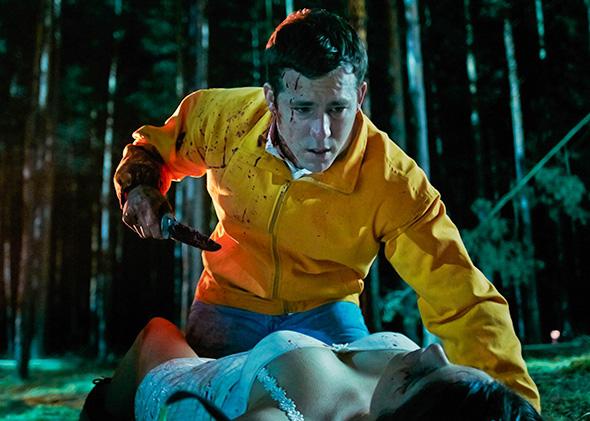Much of the audience drawn to The Voices, which opens Friday in theaters and on demand, will fall into two camps. There will be those who show up primarily for its star, Ryan Reynolds, an actor known for Van Wilder and, more recently, as the Green Lantern. And there will be those who come because of the director, the beloved and celebrated author, cartoonist, and filmmaker Marjane Satrapi.
It’s safe to say these are two groups between which there is very little crossover. Reynolds is buoyant and boyish, perhaps better known for his A-list wives (Scarlett Johansson, then Blake Lively) than for his serious acting chops. Satrapi, famous for Persepolis, her prize-winning comic and film about an Iranian girl’s coming of age in the shadow of the Cultural Revolution, speaks multiple languages and lives in France. Surely her films reflect her intrinsic sophistication.
Or not. It’s Reynolds’ fans that will walk away happiest from The Voices. His performance makes the film, and even though that’s not quite the same as saving the film, I hope it’s a game-changer for him. On the other hand, Satrapi, who was brought on to the project after it was developed for another director, can’t seem to decide if she’s making an art-house picture, a paranormal thriller, a slasher movie, or a satire of workplace drudgery. And while she and screenwriter Michael R. Perry were presumably aiming to combine all of these genres into one creepy, arty gestalt—Twin Peaks meets Office Space—the film is mostly a mess, albeit an occasionally endearing one.
Reynolds plays Jerry Hickfang, an affable if socially awkward man who works in a bathtub factory in a geographically unspecified small town called Milton. He shares a dim and dingy apartment with his dog and cat, which play the roles, respectively, of angel and devil on his shoulders. Bosco the dog dispenses avuncular, commonsensical advice. The cat, Mr. Whiskers, speaks in a sinister Scottish brogue and, when not announcing mealtime—“where’s my fucking food, fuckface?”—eggs on Jerry’s worst instincts as his unrequited infatuation with a pretty girl from work (Gemma Arterton) spirals into a killing spree.
Bosco and Mr. Whiskers aren’t the only voices in Jerry’s head. Indeed, eventually the disembodied head of a murder victim joins this close knit audio-hallucinatory family, chatting not unkindly from his refrigerator. For the film’s first 30 minutes, there’s a Truman Show quality to Jerry’s odd behavior, Reynolds’ physicality even calls to mind a less elastic, though similarly earnest, Jim Carrey. But when we see Jerry in his psychiatrist’s office admitting that he’s been off his meds and hinting at a history of psychosis-induced murder, things take a darker, weirder turn. It seems Jerry inherited his mental illness from his mother, who slit her own neck in front of him when he was a small boy and asked him to finish the job. The guy is damaged.
But wait, there’s more—and, yet again, much of it seems to be from a different film entirely. Jerry begins a fledgling relationship with Lisa (Anna Kendrick), another girl from accounting who actually likes him. The way the morning light streams through her window after they’ve spend the night together suggests there might be hope for them. But soon Jerry’s fridge becomes more crowded still, and the film concludes with murder, kidnapping, and a massive fire that suggests the filmmakers were simply out of ideas.
For all its herky-jerky dissociation, The Voices has flashes of brilliance. In a few sequences, Satrapi toggles between Jerry’s apartment as the bright, orderly space he sees and the filthy and cluttered hovel it really is. The bulk of the film—not just the talking animals and talking heads but also the happy-go-lucky workplace banter and the wholesome, no-place-and-anyplace vibe of small-town Milton—is seen though Jerry’s eyes. But over the course of a few chilling moments, the audience grasps the extent of Jerry’s delusions. And because the movie has made these delusions ours as well, we become one with Jerry in a way that engenders a kind of horrifying empathy.
Of course, the conceit of not knowing what’s real and what’s not offers a handy excuse for the kind of stylistic and tonal incongruity that plagues The Voices. Is a scene stiffly acted and strangely lit because we’re seeing it through the eyes of a madman? Or is it just stiffly acted and weirdly lit? Are the abrupt shifts in sensibility, which include a Bollywood-esque dance sequence tacked on to the end of the film, a deliberate choice on Satrapi’s part to bend genres? Or are they the result of not having enough raw material from which to carve something cohesive? Is the wisecracking, heavily accented Indian guy at work—yes, the one who shows up in every contemporary movie about corporate disaffection (he works in IT even if he doesn’t work in IT)—merely a figment of Jerry’s imagination? Or did the filmmakers simply lack the imagination to push past the stereotypes?
Satrapi’s fans may or may not be inclined to give her the benefit of the doubt. Part of the pleasure of Persepolis was the singularity of its voice. For all its magical undertones, you were always sure who was talking to you. This film has the opposite effect, and most of what works about it is due to Reynolds. The many voices in The Voices belong not to Satrapi but to him (figuratively, but also literally—he voices the dog and cat, too). Reynolds is an actor whose relatively quiet career is almost certain to get louder. As for Satrapi’s directing career, it’s hard not to think of her autobiographical narrator’s laments in Persepolis: “I was playing a game by someone else’s rules.” Maybe it’s time for a return to the drawing board.
